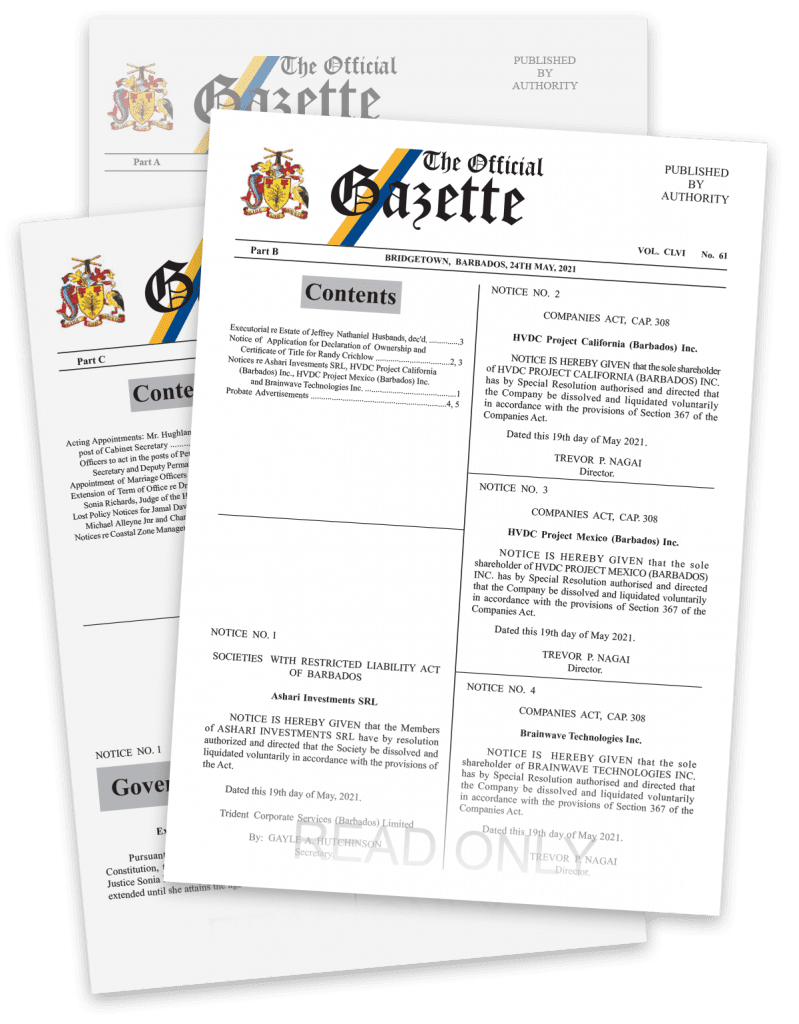S.I. 2024 No. 27
Barbados Water Authority Act CAP. 274A
BARBADOS WATER AUTHORITY (WATER PROTECTION ZONES) ORDER, 2024
The Board of the Barbados Water Authority, in exercise of the powers conferred on it by section 27 of the Barbados Water Authority Act, with the approval of the Minister, makes the following Order:
- This Order may be cited as the Barbados Water Authority (Water Protection Zones) Order, 2024.
- In this Order, “suckwell” means a well or shaft
(a) which is excavated in the ground and usually connected to a fissure;
(b) the depth of which does not reach the groundwater table; and
(c) which is used for wastewater disposal. - There shall be 6 water protection zones across Barbados for the
protection of the aquifer, the public water supply and the marine environment, classified as follows and delineated on the map set out in the Schedule:
(a)
an Exclusion Zone, to be known as “Zone A”, being an area where strict controls are necessary to protect the quality of the groundwater supply due to the rapid 90-day travel time for microorganisms, pollutants and other contaminants to seep through the soil and rock layers in the area to the aquifer;
(b)
a Pathogen Management Zone, to be known as “Zone B”, being an area where strict controls are necessary to enhance the protection of Zone
A due to the 91-day to 300-day travel time for microorganisms, pollutants and other contaminants to seep through the soil and rock layers in the area to the aquifer;
(c)
a Chemical Management Zone, to be known as “Zone C”, being an area where strict controls are necessary due to the 301-day to 730-day travel time for microorganisms, pollutants and other contaminants to seep through the soil and rock layers in the area to the aquifer;
(d)
an Aquifer Recharge Contributing Area, to be known as “Zone D”, being an area where the replenishment of the aquifer occurs;
(e)
a Non-Recharge Contributing Area, to be known as “Zone E”, being an area which does not recharge or replenish the aquifer and for which no specific restrictions are necessary for the purposes of the Act but may be imposed under the Scotland District Authority Act, Cap. 395B or the Soil Conservation (Scotland District) Act, Cap. 396 or any other enactment;
(f)
a Desalination Zone, to be known as “Zone F”, being a protection area surrounding a well field used to produce brackish or seawater feed-water for the process of desalination, that is within a 90-day travel time boundary demarcated to protect the feed-water quality and the operations of a desalination plant.
4.(1) The following activities are prohibited in Zone A:
(a)
any development that is not related to the supply, treatment and management of water in accordance with a physical development plan for the area;
(b)
livestock farming or animal husbandry and the operation of animal sanctuaries or zoos or any other facility for the housing of animals;
(c)
the generation of animal waste, manure or pathogens;
(d)
the storage and disposal of manure;
(e)
the application or use of a manure-based or a chemical-based fertilizer to or on land;
(f)
the use of any other chemical for agricultural purposes;
(g)
the storage in excess of such quantity of fertilizers as may be prescribed under the Act or any other enactment;
(h)
the storage in excess of such quantity of agricultural chemicals as may be prescribed under the Act or any other enactment;
(i)
the storage in excess of such quantity of domestic cleaners as may be prescribed under the Act or any other enactment;
(j)
the storage in excess of such quantity of industrial cleaners and other cleaners as may be prescribed under the Act or any other enactment;
(k)
the manufacture of chemicals;
(l)
the storage and handling of fuel and fuel products;
(m)
the storage and handling of dry cleaning products;
(n)
waste disposal from
(i)
sugar factories;
(ii)
distilleries;
(iii) chemical plants; and
(iv) other manufacturing or industrial activities;
(o)
the recycling, preparation for recycling or scrapping of metals and plastics, automobiles, appliances and other machinery;
(p)
the use of battery storage systems such as systems normally used in connection with the generation of energy from renewable sources of energy, the recycling of batteries and the storage in excess of such quantity of batteries as may be prescribed under the Act or any other enactment;
(q)
the operation of crematoria;
(r)
the operation of landfills;
(s)
quarrying and the operation of quarries;
(t)
the use of suckwells as the primary means of treatment of sewage and wastewater; and
(u)
the use of drainage wells.
(2) The following activities are prohibited in Zone B:
(a)
livestock farming or animal husbandry and the operation of animal sanctuaries or zoos or any other facility for the housing of animals;
(b)
the generation of animal waste, manure or pathogens;
(c)
the storage and disposal of manure;
(d)
the application or use of a manure-based fertilizer to or on land;
(e)
the storage in excess of such quantity of fertilizers as may be prescribed under the Act or any other enactment;
(f)
the storage in excess of such quantity of agricultural chemicals as may be prescribed under the Act or any other enactment;
(g)
the storage in excess of such quantity of domestic cleaners as may be prescribed under the Act or any other enactment;
(h)
the storage in excess of such quantity of industrial cleaners and other cleaners as may be prescribed under the Act or any other enactment;
(i)
the manufacture of chemicals;
(j)
the storage and handling of fuel and fuel products;
(k)
the storage and handling of dry cleaning products;
(l)
waste disposal from
(i) sugar factories;
(ii) distilleries;
(iii) chemical plants; and
(iv) other manufacturing or industrial activities;
(m)
the recycling, preparation for recycling or scrapping of metals and plastics, automobiles, appliances and other machinery;
(n)
the use of battery storage systems such as systems normally used in connection with the generation of energy from renewable sources of energy, the recycling of batteries and the storage in excess of such quantity of batteries as may be prescribed under the Act or any other enactment;
(o)
the operation of crematoria;
(p)
the operation of landfills;
(q)
quarrying and the operation of quarries; and
(r)
the use of suckwells as the primary means of treatment of sewage and wastewater.
(3)
The following activities are prohibited in Zone C:
(a)
the storage and handling of fuel and fuel products; and
(b)
the use of suckwells as the primary means of treatment of sewage and wastewater.
(4)
The use of suckwells as the primary means of treatment of sewage and wastewater is prohibited in
(a)
Zone D, from 1st January, 2029; and
(b)
Zones E and F.
(5)
A person who contravenes paragraph (1), (2), (3) or (4) is guilty of an offence and is liable on summary conviction to a fine of $10 000 or to a term of imprisonment for one year or to both.
5.(1) This Order does not apply to
(a)
an existing structure;
(b)
the existing use of an existing structure; or
(c)
land being used as a farm where the farm was being used for such purpose before the commencement of this Order.
(2) For the purposes of this paragraph,
“existing structure” means a building or structure or a partially completed building or structure which
(a)
existed before the commencement of this Order; and
(b)
was constructed in accordance with the Laws of Barbados in relation to the requisite permissions and approvals for such construction;
“existing use” means any lawful activity or purpose related to a business, including manufacturing or agriculture, or the needs of a household;
“farm” includes animal husbandry, the growing of crops or fallow land.
MAP OF THE WATER PROTECTION ZONES OF BARBADOS

Made by the Board of the Barbados Water Authority this 22nd day of May, 2024.
D. WRIGHT
Chairman
Board of the Barbados Water Authority
Approved by the Minister this 22nd day of May, 2024.
MIA AMOR MOTTLEY
Minister responsible for Water Resources


